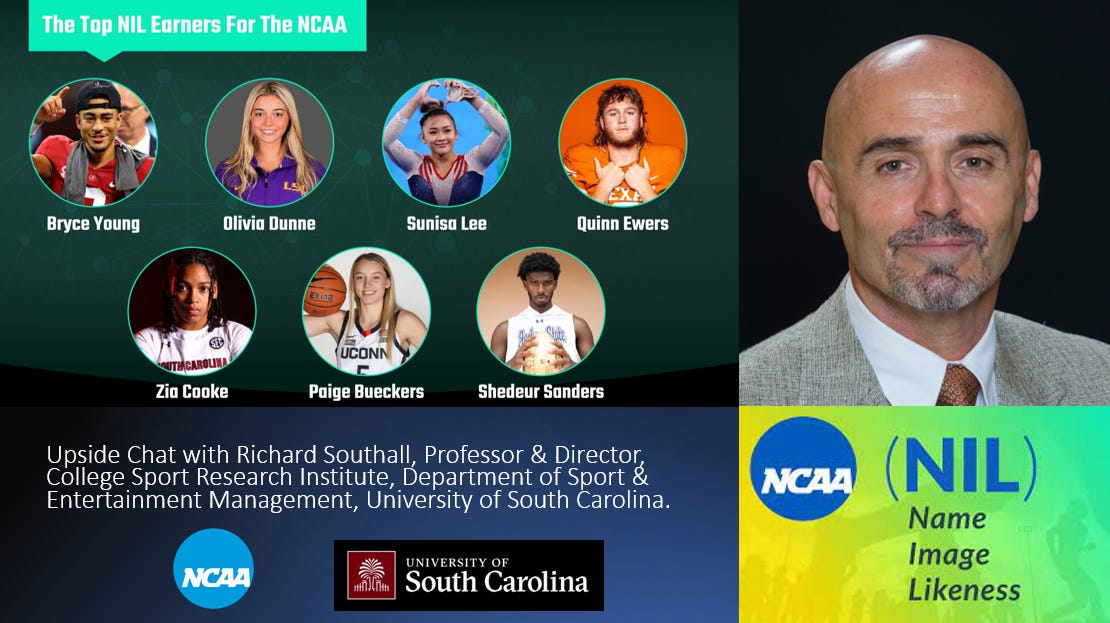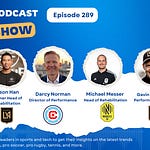This week we have the honor to interview Richard Southall, Professor and Director – College Sport Research Institute, Department of Sport and Entertainment Management, at the University of South Carolina.
If you want to meet Richard Southall in person he will be speaking on our panel on “How the NIL is changing the game for college athletes” at our annual Upside Sports tech summit on November 15, 2023 at City Field, the home of the NY Mets (MLB). You can book your pass now for our Sports tech summit to get a chance to meet him in person:
📝Show Notes: Through this interview, we touched on his background. Then we discussed the NIL, and if we are making progress there. We also touched on major issues with the NIL that he is currently seeing, and what he would do to make the NIL better for college athletes.
🚀Best Quotes: Here’s some of the key discussion points and best quotes from our conversation with Richard:
On his background:
“For the last 23 years, I've been a researcher in the college sport space. I primarily focus on Power Five football, and Division I men's and women's basketball, and the sports and the social, cultural, political, and economic issues in college sport.”
On what the NIL is and the current issues with it:
“Name, image, and likeness is a right that every citizen has. They have the right to profit off their name, image, and likeness. So, it's not something that the NCAA has suddenly granted to individuals.”
NIL or name, image, and likeness is in my opinion, pretty much a false flag, which takes the focus off the employment status of many college athletes.”
“What's fascinating is how the name, image, and likeness space has been characterized by people involved with the NCAA and other governing bodies and other lobbying entities, as a Wild West situation that is totally out of control and leading to chaos, et cetera. I don't see that being the case.”
“NIL is detrimental to some college athletes because it results in their classification as independent contractors. They're not gaining access to the true value of the market their labor produces, which includes media rights deals, ticket revenue, concessions, merchandise, etc. They're not gaining access to any of that. They're having to go out and get a part-time job, or even a full-time job to supplement their grant-in-aid compensation. ”
On the fact that the NCAA is pushing for a standardization of the NIL contracts and his belief that the NCAA is using a diversionary tactic with the NIL:
“Many of the stakeholders involved in college sport (the athletic administrators, coaches, lobbying organizations) have been to Congress recently, wanting to create a registry for transparency in name, image, and likeness deals. They want to get an agent certification process and a uniform standard NIL contract.”
“Notably, these three things are dealt with in professional sport as part of collective bargaining between labor (employees through a player's association) and management. At the same time these stakeholders are asking for these things, they want to ensure college profit-athletes are deemed to be students and not employees. They want it both ways.”
“They want preemption of all state NIL laws, to make sure all college athletes are deemed students and not employees, and they also want the NCAA to be granted an antitrust or limited antitrust exemption. None of these are really related to NIL. In my opinion, what's happening is name, image, and likeness is a diversionary tactic, so to speak, to take the focus off the real things the stakeholders want”.
On why he believes that the NCAA does not want college athletes to be considered employees:
“Because if they're employees, then you have to collectively bargain with them. They do not want to deal with a players’ association. They don't want to deal with workers' compensation issues, which is a big issue. So, what they're trying to do is to lump all college athletes together.”
On the 2 types of college athletes:
“The first category of college athlete is “profit athlete.” Profit athletes are college athletes whose market value is greater than their grant-in-aid (GIA) compensation. While a college grant-in-aid (which might include a tuition fee waiver, room and board, et cetera, et cetera), is valuable, many times a profit athlete (for example, a Power Five football player), has a market value that greatly exceeds that GIA compensation level”.
“On the other hand, a “loss athlete” is an athlete whose market value is less than the GIA compensation they receive. Loss athletes may be receiving GIA compensation that greatly exceeds their market value.”
On his belief that not all college athletes should be considered as employees:
“For a loss athlete, it is in their benefit to not be an employee because their market value is less than the value of their GIA and other support. So, when the new president of the NCAA says he's never visited with a college athlete who says that they want to be an employee, that might be true, since probably 95-97% of college athletes are “loss” athletes and should not be viewed as employees. These loss athletes know they have little market value and should not be viewed as employees. However, that does not mean it is okay to exploit the labor of the 3-5% of college athletes that are profit-athletes. That’s our moral dilemma.”
“Not all college athletes should be deemed employees. Clearly, some college athletes are employees. We need to differentiate between the two. All college athletes have access to their name, image, and likeness, and should be able to monetize it. The more restrictions we put upon that I think is bad.”
“And I find it fascinating that many times, college sport stakeholders (e.g., coaches and administrators, NCAA staff and lobbyists) or legislators – who in almost any other situation are free market capitalists and say we need to have free and unfettered markets – when it comes to college profit-athletes, all of a sudden these stakeholders want strict regulation and talk about guardrails and everything being out of control and it being the Wild West, and we need to tightly regulate this market. They don't want regulation in any other market; they don’t want regulation of their compensation but want to regulate profit-athlete compensation.”
On whether or not we are making progress with NIL:
“It's better than it used to be. But again, as I tell folks, don't take your eye off the ball because of name, image, and likeness. So, let's say for example, I'm a music major at Duke University and I want to record an EP and go out and sell that. Of course, I can do that. The college is not going to get involved in that”.
“But when we talk about a name, image, and likeness contract for a Power Five football player, all of a sudden athletic administrators want to be deeply involved in what's going on there. The proper entity to be representing college profit-athletes is a college profit-athlete players association, not a parochial or paternal organization like the NCAA. You can't have management representing labor.”
On his belief that we should not have a federal regulation with the NIL but instead a state regulation:
“I really think that we should let the state regulation take the lead here. I don't see the need for federal legislation. We have a number of industries that are regulated on the state level.”
“And so, this call for federal regulation of name, image, and likeness, I think, is again not necessarily in the players’ best interest. It should be able to be negotiated on a case-by-case basis. And if you want to talk about agents being regulated, most often agents are regulated by players associations. For example, the NFLPA regulates NFL football players agents.”
“So, I think there's a lot of things in the NIL that we should be addressing, but I think this federal preemption that folks are talking about, is I think the wrong way to be looking at it.”
On the fact that on average D-I college athlete NIL compensation is $2000 to $3000 per year:
“We're talking about average NIL compensation in the lower four figures ($2000 to $3,000) on average, which quite frankly, is not a lot of money.”
“And everybody seems to be referring to, and as you alluded to early on, LeBron James' son has a $10M NIL contract with Nike. Well, we're focusing in on sample sizes that we can count on one hand, right? We're talking about a few examples of huge amounts of money, and everybody focuses on that.”
On what he would do to make the NIL better:
“In the future, I would abide by the guidelines that will be outlined in the forthcoming ruling of the National Labor Relations Board (NLRB). I don't know how the NLRB going to rule, but if the National Labor Relations Board deems that some college athletes are employees, I think those college athletes that are employees should be involved in a group licensing agreement as well as individual licensing agreements.”
“All college athletes should have the right to negotiate individual contracts for their name, image, and likeness. That I don't see any reason for governmental intervention in that capacity.”
On the fact that no one is calling for a standard coaching contract in college sports:
“What I find fascinating is that nobody is calling for a standard coaching contracts in which every coach has to be compensated the same way.”
“While the average college football assistant coaches’ salary is nearing a million dollars a year, we know we can't do anything to “fix” their salary at a predetermined level because that's an antitrust violation (Law v. NCAA, 1998). The NCAA tried to do that in the Law v. NCAA case years ago. They tried to limit what a college coach could make.”
“Courts don’t usually ignore antitrust violations. But the NCAA continues to want to go to Congress and get an antitrust exemption.”
On how the NIL is likely to evolve in the coming years:
“I think it'll continue the way it is right now. I don't think that there's going to be federal preemption of state regulation. I think that the college athlete marketplace will reach a point of equilibrium. And quite frankly, I don't see that things are going to get out of control and everybody's going to go crazy.”
“Everybody's worried about the “haves” getting more. Well, I think name, image, and likeness could actually have the opposite effect and have players go “have-not” schools that have effective marketing strategies. However, by and large, athletes are athletes, they’re not marketing brands.”
You may also like:
🔥Upside Chat: Alexi Pianosi, Strengths and Conditioning Coach, Pittsburgh Penguins (NHL)
🔥Upside Chat: Pierre Barrieu, High Performance Director, Toronto FC (MLS)
🔮 2022 Upside Top Sports Tech Predictions (NFT/Metaverse, Sports Performance, IPOs/M&As..)











